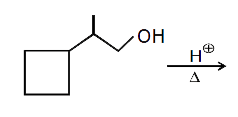(i) CH3C∣H3ChC∣OHHCH3H+−−→ΔI+II(major)
(ii) IHBr−−−→in darkIII+IV(major)
The major products I and III are respectively- Solution in Bengali
CH2=CH3∣C−CH2CH3&CH3−CH3∣CBr−CH2−CH3
CH2=CH3∣C−CH2CH3&Br∣CH3−CH3∣CH−CH2−CH3
CH3−CH3∣C=CHCH3&CH3−CH3∣CBr−CH2−CH3
CH3−CH3∣C=CH−CH3&CH3−CH∣CH3−Br∣CH−CH3
Topper's Solved these Questions
- HYDROCARBONSBOOK - CHHAYA PUBLICATIONCHAPTER - HYDROCARBONSEXERCISE - ENTRANCE QUESTION BANK (JEE- Main) ENGINEERING AND MEDICAL ARCHIVE
12 Videos
- HYDROCARBONSBOOK - CHHAYA PUBLICATIONCHAPTER - HYDROCARBONSEXERCISE - MCQ HOTSPOT
115 Videos
- HYDROCARBONSBOOK - CHHAYA PUBLICATIONCHAPTER - HYDROCARBONSEXERCISE - HIGHER ORDER THINKING SKILL (HOTS) QUESTIONS
35 Videos
- HALOAKANES AND HALOARENESBOOK - CHHAYA PUBLICATIONCHAPTER - HALOAKANES AND HALOARENESEXERCISE - Practise set 10 (Answer the following questions)
10 Videos
- HYDROGENBOOK - CHHAYA PUBLICATIONCHAPTER - HYDROGENEXERCISE - PRACTICE SET -9
5 Videos
Similar Questions
Formaldehyde is one of the products obtained on ozonolysis of a compound. The presence of which of the following groups is proved by this observation-
View SolutionThe correct order of decreasing boiling points of the following hydrocarbons is -
a) n-butane
b) 2-methylbutane
c) n-pentane
d) 2,2-dimethylpropane
View SolutionWrite the formulas and names of the alkenes which on hydrogenation form 2-methylpentane.
View SolutionWhy CH3Cl is easily hydrolysed than C6H5Cl?
View SolutionWhat is calgon?
View SolutionIn the follwing reactions,
(a) H3C−CH3| CH−CH∣ OH−CH3H+/heat−−−−−→AMajorproduct+BMinorproduct
(b) AHBr,dark−−−−−−−−−−−−→in absence of peroxideCMajorproduct+DMinorproduct
The major products (A) and (C) are respectively:
View SolutionPh−OH∣C∣Me−Me∣C∣I−PhAgNO3−−−→Δ? Major product is
View SolutionStatement-I, underset("Major product")(Me-overset(OH)overset(|)(C)H-underset(Br)underset(|)(C)H-Et) Statement-II: Me exert less steric hindrance than -Et group.
View SolutionIn the following reactions , (1)CH_3-oversetoverset(CH_3)|CH-undersetunderset(OH)|CH-CH_3overset(H^+//heat)to underset"(Major product)"A+underset"(Minor Product)"B (2) A underset"in absence of peroxide"overset"HBr, dark"to underset"(Major Product )"C+underset"(Minor Product)"D The major products (A) and (C )are respectively
View SolutionIn the following reactions, (i) CH_(3)-overset(CH_(3))overset(|)(C)H-underset(OH)underset(|)(C)H-CH_(3) overset(H^(+)//Heat)to underset(("Major products"))(A)+underset(("Minor products"))(B) (ii) A underset("in absence of peroxide")overset(HBr,dark)to underset(("Major products"))(C)+underset(("Minor products"))(D) The major products (A) and (C) are respectively
View SolutionIn the following reaction :
H3C−CH3∣C∣CH3−CH=CH2H2O/H+−−−−−→I+IImajor product minor product
The major product is -
View Solution
H⊕−−→Δ Major product
Major product is
View SolutionPh-overset(Ph)overset(|)underset(H)underset(|)C-overset(H)overset(|)underset(CH_3)underset(|)C-CH_2-OH overset(H^+)underset(Delta)to Product Select the correct P.E. graph for major product.
View SolutionCH_3-overset(CH_3)overset(|)underset(OH)underset(|)C-overset(CH_3)overset(|)underset(OH)underset(|)C-CH_3 overset(H^+)underset(Delta)to (P) (Major) Major product (P) is :
View SolutionIn the following reaction equation, what is A and C ? (i) CH_(3)-overset(CH_(3))overset(|)CH-underset(OH)underset(|)CH-CH_(3) overset(H^(+)//"Heat")to underset("Main product") (A)+ underset("By product")(B) ii) A overset("HBr, dark")to underset("Main product") (C) +underset("By product")(D)
View Solution

